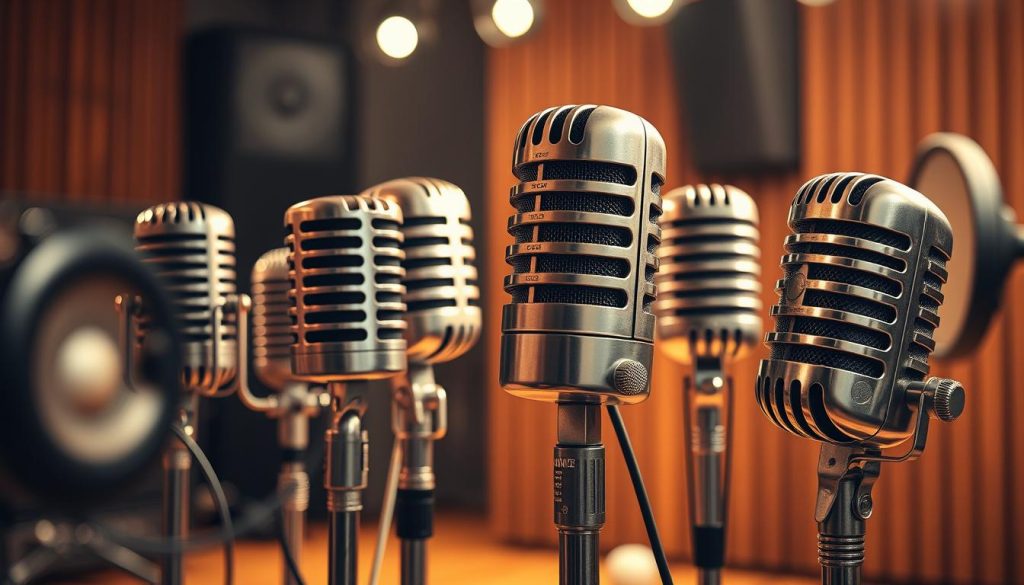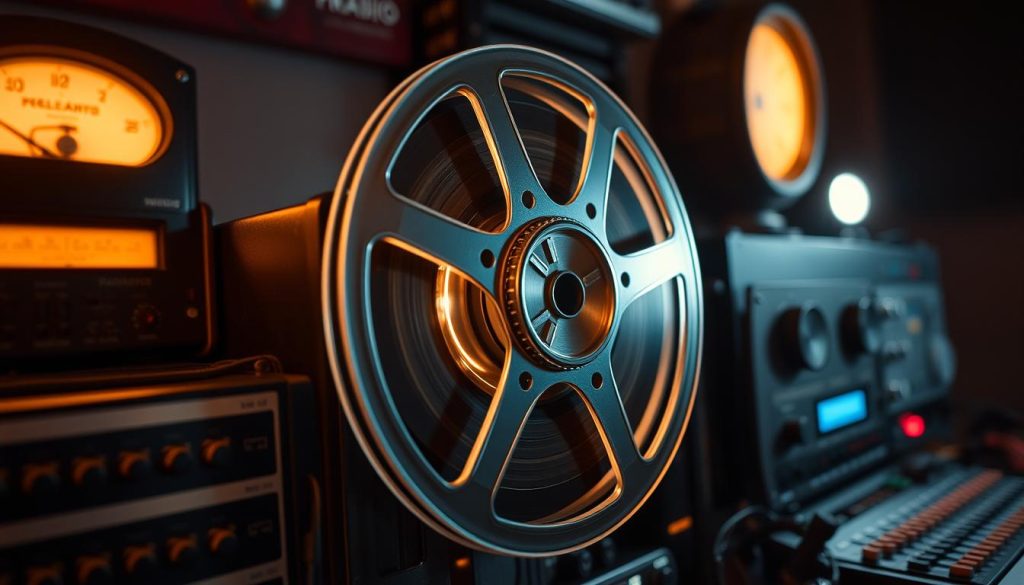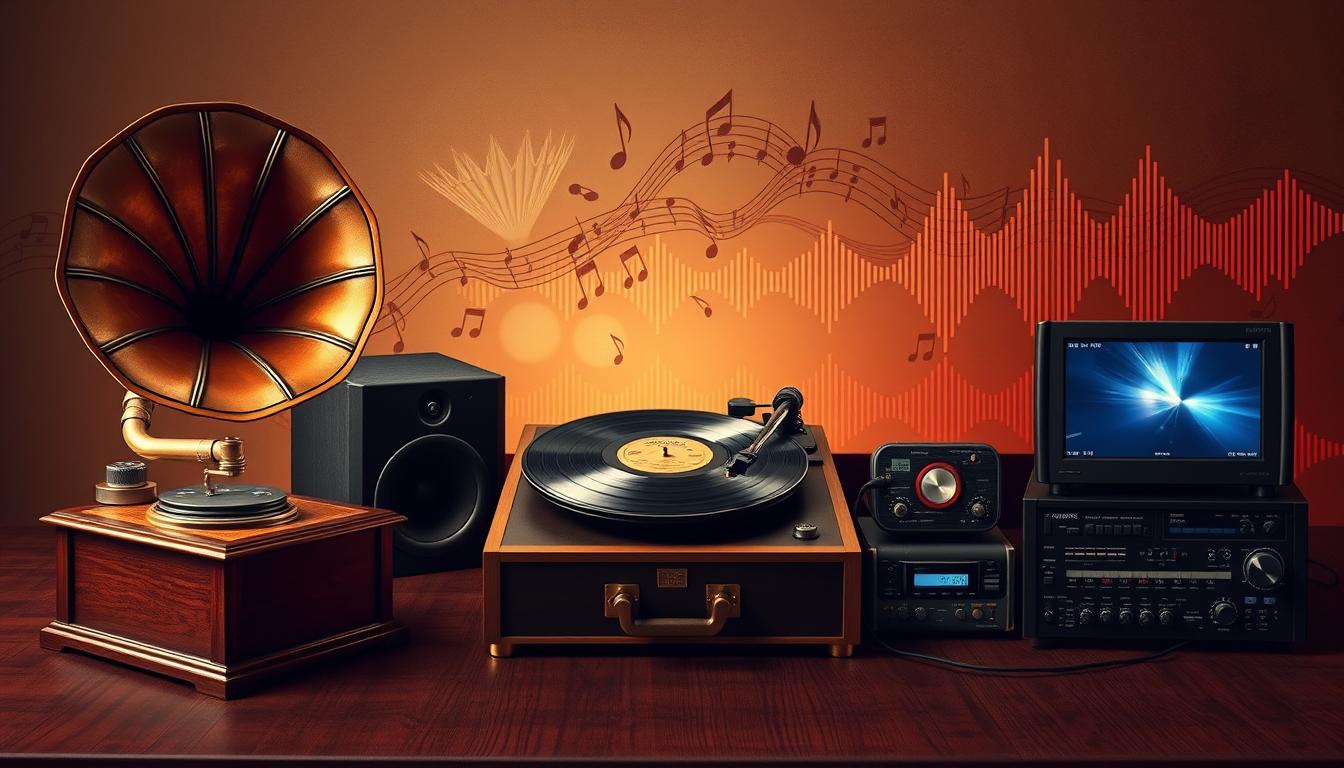The history of sound recording is truly amazing. It has seen many new technologies. These have changed how we hear and enjoy music. As someone who loves music, I find this story very interesting.
It started with wax cylinders and has moved to today’s digital tech. I’ve learned a lot about this journey. It shows how far we’ve come in recording and playing back sounds.
Thomas Edison was one of the first big names in this field. Then came magnetic tape and digital tech. These changes have made sharing and enjoying music easier and better.
In this article, we’ll look at the different eras of sound recording. We’ll see the important tech and events that changed the industry. Let’s explore how sound recording has evolved from its early days to today’s digital world.
The Acoustic Era: Birth of Sound Recording
The first sound recording devices were mechanical. They used the sound waves’ physical properties to capture audio. These systems had a big horn to focus sound waves onto a sensitive diaphragm. This diaphragm, linked to a stylus, etched the sound onto wax cylinders or discs.
Thomas Edison’s Phonograph: The First Recording Device
Thomas Edison’s phonograph, from 1877, was a key early sound recorder. It used a thin metal foil on a spinning cylinder to record sound. When sound waves made the diaphragm vibrate, the stylus indented the foil. This was a big step, starting the era of wax cylinder recordings and acoustic recording technology.
Capturing Sound Waves: The Mechanics of Early Recorders
These early phonographs didn’t capture sound well. They only picked up a small part of what we can hear. Musicians had to play loudly and arrange their music carefully. By the end, discs became the main way to record sound, offering better quality than wax cylinders.
| Key Features of Acoustic Recording | Limitations of Acoustic Recording |
|---|---|
|
|
The Electrical Era: Amplifying Sound

In 1925, Western Electric introduced a big change in sound recording. They used electrical microphones, electronic amplifiers, and electromechanical recorders together. This made recording sound better and easier.
This new system made sound clearer and richer. It helped audio engineers capture more details. Singers started to perform differently, leading to the crooner style.
At the same time, sound-on-film technology got better. This made movies more enjoyable for everyone.
Electrical microphones and electronic amplifiers changed music forever. They made recorded sound better and changed how musicians performed. This led to the crooning genre.
As time went on, audio experts kept finding new ways to improve sound recording. They used electrical microphones, electronic amplifiers, and more to create new sounds.
The electrical era was a big step for sound recording. It let audio pros control sound better. This opened up new ways for musicians to express themselves.
Sound Recording Evolution: Magnetic Tape Revolutionizes Audio

In 1945, magnetic tape recording started a new era in audio history. It was a big leap forward from the old phonograph disc. This tech improved sound quality and let recording engineers be more creative.
Multitrack Recording and Editing Capabilities
Magnetic tape made multitrack recording possible. Engineers could record different sounds separately and mix them later. This opened new doors for music makers to try out complex sounds and arrangements.
Also, magnetic tape was easy to edit. Engineers could cut and splice it with ease, unlike phonograph discs. This let them shape sounds in ways never before possible, starting a new chapter in music production.
The Rise of Analog Multitrack Tape Machines
At places like Abbey Road, analog multitrack tape machines became key. They let engineers record different tracks separately. This gave them total control over the mix, leading to more complex and detailed music.
Magnetic tape changed the music industry a lot. It changed how sound was recorded and shaped. It led to the modern era of magnetic tape recording, analog multi-track, and tape-based music production.
The Portable Music Revolution: Cassette Tapes
The 1960s brought a big change with the compact audio cassette tape. Dutch engineer Lou Ottens created it. This made music easy to carry around, unlike the big reel-to-reel machines before.
Cassette tapes let people take their favorite audio cassette tapes anywhere. This started a new time of portable music players and compact and accessible audio.
At first, cassette tapes didn’t sound as good as other formats. But they were easy to use and carry. This made them very popular, changing music and how we listen to it.
Audio cassette tapes and portable music players made listening to music on the move possible. This changed the music industry and how we enjoy our favorite songs. It made music more personal and free.
The Digital Era: Compact Discs and Beyond
In the 1980s, compact discs (CDs) changed the music world. They offered better sound quality and could hold more music than old formats. The Bee Gees’ album “Living Eyes” was one of the first to show off this new tech.
By the 2000s and 2010s, digital music and sites like iTunes and Spotify became popular. This move from CDs to digital changed how we listen to music. Now, streaming services are big, and CDs are less used.
The Transition from Physical Media to Digital Audio Files
Switching from CDs to digital music was a big step. Fast internet and smartphones made digital music easy to use. Now, fans can listen to their favorite songs anywhere, without CDs.
| Compact Discs | Digital Audio Files |
|---|---|
| Physical media with limited storage | Unlimited digital storage and accessibility |
| Require physical player devices | Playable on a variety of digital devices |
| Susceptible to physical damage | Durable and less prone to damage |
This change has changed how we enjoy music and affected the music industry. It led to more streaming services and fewer CDs.
Exploring the Future of Sound Recording
I love music and I’m excited about the new changes in sound recording. The future looks amazing, with new audio technologies coming our way. I’m eager to see how they will change music creation and listening.
Immersive audio formats like Dolby Atmos and binaural recording are really cool. They make music feel more real and immersive. Listeners feel like they’re right in the middle of the music, thanks to these new sounds.
AI is also changing music production. AI tools are making sound design better and mixing music smarter. They can even make music just for you, based on what you like. I’m curious to see how AI will help artists make music that’s even more amazing.

